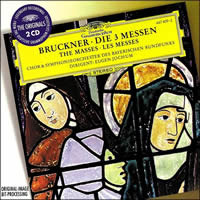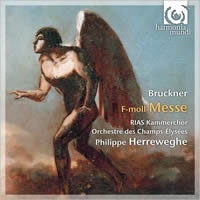Three, by Two
|
Dan Albertson [January 2009.]
Anton BRUCKNER: Mass No. 3 in F minor. Maria Stader (sop), Claudia Hellmann (alt), Ernst Haefliger (ten), Kim Borg (bs), Anton Nowakowski (org), Chor und Symphonie-Orchester des Bayerischen Rundfunks, Eugen Jochum (cond.). Deutsche Grammophon 423 127-2 (423 130-2 within a four-disc set; other pressings and other compilations have been issued subsequently, but my reference was this box from the late 1980s) (http://www.deutschegrammophon.com/). Anton BRUCKNER: Mass No. 3 in F minor. Ingela Bohlin (sop), Ingeborg Danz (alt), Hans Jörg Mammel (ten), Alfred Reiter (bar), RIAS Kammerchor, Orchestre des Champs-Élysées, Philippe Herreweghe (cond.). Harmonia Mundi HMC 901976 (http://www.harmoniamundi.com/). Bruckner’s Third mass is not in fact his third, nor are the numbers of his symphonies reflective of their chronology. This mass, his last, shares with its symphonic brethren a tangled history of revisions. In recent years, with his recordings of the Fourth and Seventh symphonies, Philippe Herreweghe has emerged as a thought-provoking Brucknerian, though his recorded devotion began nigh 20 years ago with the Austrian’s wind-band mass. The pioneering Eugen Jochum recordings of the symphonies remain, to many ears, definitive. What follows is a brief comparison of the Herreweghe and Jochum recordings of Bruckner’s Third mass, separated by 45 years and serving as a reminder of evolving interpretive ideas, with Jochum’s informed by the Romantic tradition and Herreweghe’s by period instruments and performance practice. Bruckner: Mass No. 3
Both recordings are excellent: That Jochum’s remains competitive is both a credit to its innate musicality and to weaknesses in Herreweghe’s newer account. As the chart indicates, perhaps as a surprise, tempi are not a major point of difference. Only in the work’s core, the Credo, is a large fluctuation palpable. Sound quality is, however, an issue with Jochum, the recording’s age revealing less definition during choral contributions. Both teams of soloists are evenly matched, though in both renditions one is at times aware of gestures more operatic than sacred. Jochum’s string sound is more polished and monolithic, often at the expense of the winds. Herreweghe’s smaller band, with fewer than 50 strings, allows a clearer picture of the work’s structure and is, with its gut strings, also nimbler. Neither recording is showy, a fact sure to be welcomed by devotees of both traditions. Though Herreweghe employs a smaller dynamic range, more of the music is heard this way. Jochum, by contrast, brings out tremendous swings of volume, leaving some quiet moments nearly inaudible and some joyous sections overbearing. Three highlights of this work for me are: (1) the massive build-up of voices and instruments before the quiet coda of the opening Kyrie; (2) the riotous Et resurrexit section of the Credo; and (3) the pure contemplation of the Agnus Dei. In (1), the recordings differ considerably. For Jochum, this section is treated as an accelerando, with steady gradations in tempi leading to a frenzy. Herreweghe keeps his tempo on the moderate side, with only a slight step up toward the end. The brass of (2) are fuller and louder for Jochum than for Herreweghe, with the latter managing more nuance. Deciding which (3) is more beautiful is too difficult a call. I will defer and report only that, while both versions are fine, Herreweghe extracts a clearer sound from his leaner chorus. Two major obstacles prevent me from making a whole-hearted recommendation of the Herreweghe disc: the lack of pairings and the missing organ. The mass, though a major work, is less than an hour in length. The inclusion of some of the composer’s graduals or other motets would have been welcome. Deutsche Grammophon’s four-disc set, now out of print, pairs the masses and Te Deum with all of Bruckner’s sacred motets. Much more troublesome is Herreweghe’s exclusion, without explanation, of the organ that graces Jochum’s 1962 recording. In the Gloria and Credo in particular, the organ plays an important rôle. Perhaps Herreweghe used the score of a different version. If so, why not offer a reason? For a maestro normally so thorough in his documentation, the omission is disturbing. Jochum is a good bet for the traditionalist. Listeners with more contemporary tastes may also appreciate his performance’s charms. Likewise, Herreweghe’s warm reading is far from detached or dogmatic. His recording may well win over some listeners heretofore skeptical of Bruckner on period instruments.
[More Dan Albertson]
[More
Bruckner]
[Previous Article:
Pièces de Clavecin 4: Royer, D’Anglebert]
[Next Article:
Zweiter Spaziergang mit Rücklauf]
|

